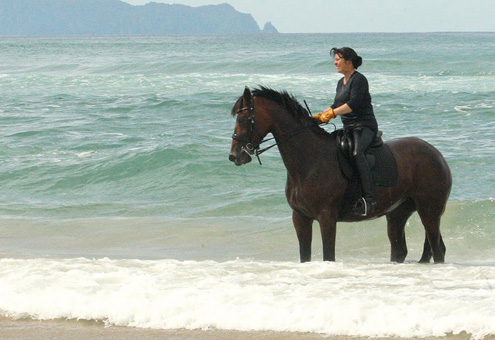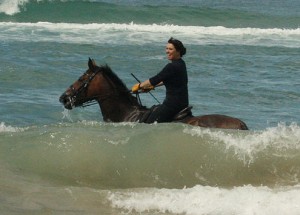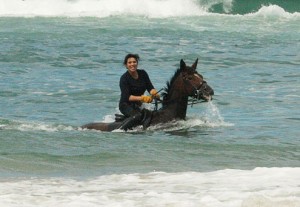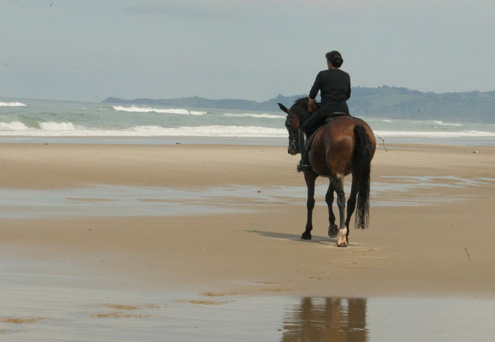Riding New Zealand
By Maggie Broekman August 21, 2011New Zealand was never on the list of places I absolutely had to visit. It’s rather remote, and for me—a German-born dressage trainer who has been living and working in Southern California for the past 20 years—it always seemed kind of remote, and in no way a nexus of equestrian sport.
But when an international judge found my Web site on the Internet and invited me to do some clinics and private lessons in February, I found myself hopping between the North and South Islands, and my opinion of the place was quite changed. There is a thriving horse community there, along with some amazing New Zealand-bred horses.
As someone who grew up in Europe and was exposed to the best breeding programs Deutschland had to offer, I have to admit, I was enormously impressed with the locally-produced Thoroughbred-Draft lines. The particular New Zealand strain is referred to as station-bred, and they are incredible movers.
If I wanted to buy a really nice dressage horse that is where I would look right now because of the way they mix the bloodlines. In addition to Clydesdales, they’ll add in some Hackney and even the Australian Brumby. The resulting horses have some really nice hock action. The bending hock is the action necessary for collection. This is measured by the spring with which the horse moves forward with its rear legs, stepping toward the saddle girth –the center of gravity– with its back rounded upward, in a convex position.
There are a lot of German stallions in New Zealand – Hanvoverians, Holsteiners, Westphalians – mainly imported from Australia. But I find that these European breeds do not have sufficient spring from behind. Personally, as a trainer, I don’t care about the color or breed of the horse. All I care about is the expression of motion, and the motion has to start from behind – from the back, towards the center of gravity. That is something that if it isn’t there naturally is difficult, if not impossible, to train into the horse. Having seen many people more impressed with the brand on the butt or the neck than the abilities of the horse, I want to take a stand, reminding buyers and breeders that in dressage, effectiveness of motion is more important than the prettiness of the horse.
One of the great things about New Zealand is that the two islands that form the country are mostly wild and undeveloped, so there is a lot of beautiful natural terrain to ride on in addition to nicely maintained stabling facilities in the countryside. (The stable facilities are mostly private and always in the country. Horses are basically kept all year round with heavy blankets, or “rugs,” as the Kiwis call them, and live outside in pastures.) Due to the overall low density, everything is just minutes from the cities.
It was in one of those arenas—at a huge show barn, only a few kilometers away from the center of Christchurch — that I was riding on Feb. 22 when I was caught in the middle of a major earthquake. The quake struck after noon, and at first I thought my horse was having a seizure because it was starting to weave really badly and I felt as if I was being shaken right off its back. I could see tremors rippling the ground, and the trees were moving as if there was a hurricane.
Then I heard really loud growling noise, and it hit me: Earthquake! Three and a half hours later, we were still getting hammered by big aftershocks. The damage was severe: people trapped in buildings, the ground liquefied in many areas, massive floods, boulders rolled down the mountains and were scattered everywhere.
Being familiar with the Biblical prophecy that in the end of days “mountains will fall into the sea, and no walls will be left standing,” I can now believe it. It looked a lot like 9/11 Manhattan: smoke and dust everywhere, people running around hysterical, crying and bleeding. The only thing notably different was the flooding everywhere. It looked like the earth was turning itself inside out.
Christchurch Cathedral, one of the South Island’s major sightseeing landmarks, had completely caved in. People were trapped under the debris. The quake measured 6.3 in magnitude, and the fault line was very shallow—initially estimated at only 5 km deep, or 3.1 miles—and only 6.2 miles away from Christchurch, which was a big part of the reason for the extensive damage.
It was a massive catastrophe, and I was right in the middle of it, but I emerged unharmed, as did the horse I was riding. Others weren’t so lucky. The final death toll was 181, and the best moving horse I’ve ever had the pleasure to ride, the Emperor, died as a result of the quake. He’d been out turned out in the field and must have sensed something bad was happening because he colicked, and because of all the mayhem the vet couldn’t get to him in time.
I didn’t find that out until later. At the time, not only did I stay cool and collected, but was able to help calm the people and horses around me. Later, watching the news, I got to see the full extent of the damage and casualty reports, heard tsunami warnings, and learned the airports were closed—the runways split open—which did not bode well for my scheduled return to Auckland in three days. It certainly gave me a lot to think about regarding earthquakes in California.
Margaretha “Maggie” Broekman is a German-licensed dressage trainer, FEI-level competitor and hunter-jumper instructor. Based primarily out of Peacock Hill Ranch in Shadow Hills, she also visits clients at their own stabling facilities. You can read more about her program at www.mb-dressage.com.
Short URL: https://theequestriannews.com/?p=4095






